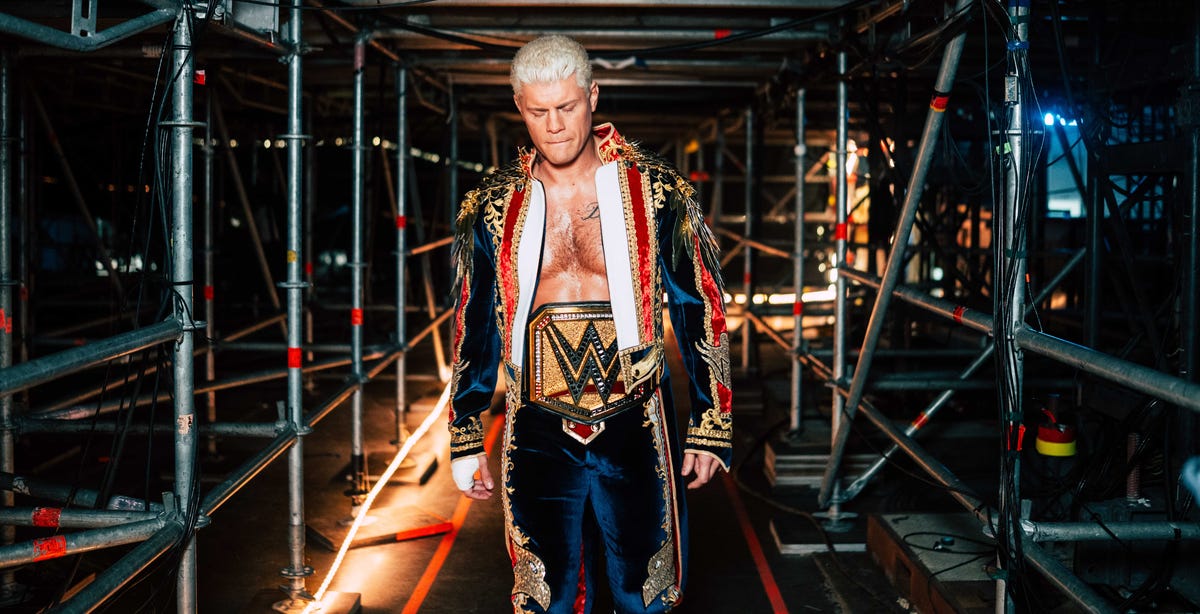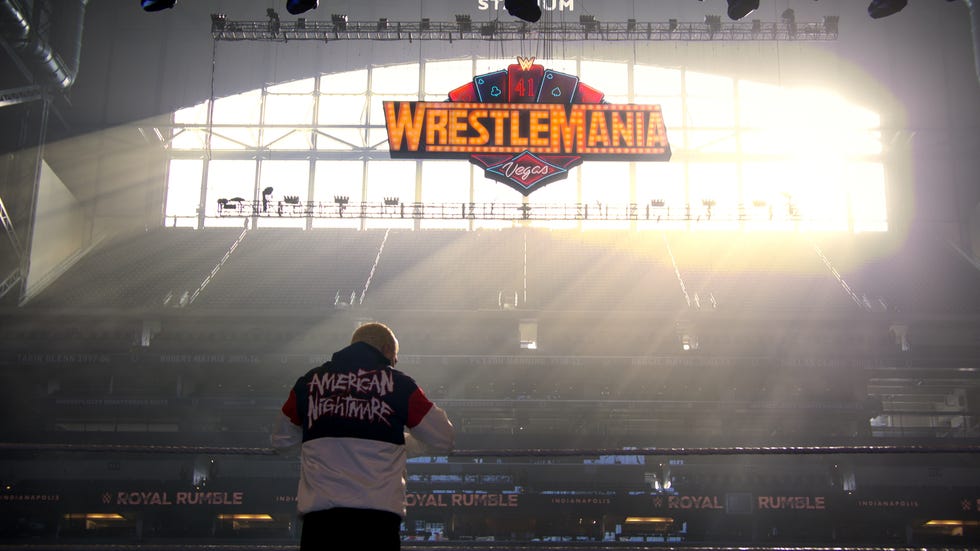<em>WWE Unreal</em> Has Pissed Off Wrestling Purists. But It’s Exactly What the Sport Needs.


How far are you willing to go to protect your job? In a bygone era of professional wrestling, an art form founded when the light bulb was a technological marvel, wrestlers were sworn to protect the business. Meaning: maintain the illusion (often referred to as "kayfabe") that everything about them and what they did was real. If two wrestlers were embroiled in a blood feud, no one could see them chowing steaks together at a restaurant. Wrestlers and promoters believed (maybe even correctly) that the illusion of costumed titans fighting each other for glory was what compelled people to spend money to see matches. No kayfabe, no business. Protect the business. It was an order. A vow.
But what does it mean to protect the business in 2025? Not since the halcyon days of the Attitude Era—when the then-named World Wrestling Federation employed generational badasses like Steve Austin and The Rock and produced edgy TV that took cues from Jerry Springer and South Park—has pro wrestling been this big. The WWE (formerly WWF) is still the premier league of professional wrestling. Following its 2023 merger with UFC to form the joint venture TKO, WWE saw a revenue of $1.3 billion in 2024 and a splashy Netflix deal that has migrated its flagship show Monday Night RAW from cable to streaming. But with audiences now reinvested in WWE's sandbox, and in great numbers, what does it take to keep their shrinking attention spans?

WWE: Unreal is a new Netflix documentary series that peels back the curtain on the production of WWE’s sell-out shows like never before.
Ironically, it might be the death of kayfabe itself. Amidst WWE's booming presence on Netflix is the new docu-series WWE: Unreal, which takes cameras deep into the locker rooms and writers' rooms (yes, WWE employs narrative writers) to reveal how the in-ring sausage is made. The first season chronicles the months and weeks leading up to WrestleMania 41, held in Las Vegas last April. It "pulls back the curtain," so stated in the series by WWE's chief content officer and de-facto showrunner Paul Levesque, himself a multi-time champion by the name Triple H.
"Drive to Survive for WWE" was clearly the elevator pitch for WWE: Unreal, with sprinklings of Greg Whiteley (Wrestlers, America's Sweethearts: Dallas Cowboys Cheerleaders) and his body of non-scripted sports dramas. The walls of kayfabe have come down brick by brick over the years, but Unreal marks its historic demolition on a scale many fans never thought possible, at least under previous management. While wrestling matches are predetermined—"winners" are figured out beforehand—and not unpredictable as in Formula 1 racing, success is still determined by the inches gained and mileage lost with the wrestling fandom. "To be in the positions of influence, you repeatedly perform well," says John Cena (currently the WWE Champion in his historic 14th reign) in the second episode. "There does get to a level where, man, it is decibel points that separates you and makes you stand out."
This is where WWE: Unreal stands at the intersection of the sacrilegious and the sublime, with the industry's old guard reacting exactly as you'd expect. There's Jim Cornette, a figure whose many jobs in the wrestling world include "booker," which is like a director and scriptwriter combined. For Cornette, WWE: Unreal is proof the sacred cows of wrestling are carcasses rotting in the sun. "It's come to this," he said with a long, exhausted sigh in an April 2025 episode of his podcast after the announcement of Unreal. "I don't want to see these fucking writers or their room, and I don't want anybody else to see it either. Because it's fucking embarrassing." The larger-than-life stars of WWE, Cornette argues, will be rendered into "trained chimpanzees" who do what they're told by "nebbish" writers.

WWE: Unreal spends as much time in the writers’ room as it does the locker room. Until now, the inside of WWE’s storytelling nexus has rarely if ever been seen, let alone recorded to let fans witness their thought process.
Cornette isn't alone in his Kentucky-flavored fury. On WWE's Instagram, the comments section of posts promoting Unreal—with clips like Cody Rhodes and Kevin Owens talking over a nasty spot during their match at Royal Rumble 2025—are full of livid old school-minded fans. "Can't lie, seeing kayfabe being broken like this from the official account is very disappointing," reads one comment. "Wrestling is supposed to be an illusion, suspension of disbelief," reads another.
For myself, a lifelong fan who grew up believing The Undertaker and Kane were actually brothers, it's baffled me how maintaining kayabe was never in conflict with what fans secretly wished the public could accept wrestling as: an art form. From Shakespearean plays to HBO Sundays, no one watching scripted entertainment harbors delusions that what's unfolding is real. Pedro Pascal wasn't murdered in The Last of Us, just as he doesn't actually have stretchy limbs in The Fantastic Four. Hearing from the writers, directors, and actors about their creative decisions do not negate our immersion into the story they're telling. If anything, they enhance it, allowing we the audience to learn more about the art we're obsessed with.
Kayfabe was a way to protect the business when we didn't carry supercomputers in our pockets. Its final breaths were drawn long ago, when matches left bingo halls and moved into arenas and stadiums. It died when Ric Flair overspent his modest fortune on limos and Rolexes to sell the illusion of his extravagant persona. It died when tight-knit WWF wrestlers—among them Triple H—bid two departing colleagues farewell in Madison Square Garden when their characters were bitter enemies. Reality TV and Mark Zuckerberg are as complicit in the death of kayfabe as fans themselves, when we each quietly accepted wrestling is make-believe but kept tuning in because, for whatever reason, we can't look away from it.
Therein lies the brilliance of WWE: Unreal. It doesn't kill kayfabe but makes it anew. The gas that fuels Unreal is the uncertainty of what happens when a wrestler's body and willpower meets the audience's emotional state. That's a scenario no one, not even WWE's staff writers, can artificially create. As the WWE has figured out themselves with the likes of John Cena and Roman Reigns, no one can tell the audience who to love or hate. The WWE can create good guys ("babyfaces") and bad guys ("heels"), but the audience chooses their heroes. The legendary "Stone Cold" Steve Austin was crafted as the ultimate heel; he spent his career as one of wrestling's biggest heroes of all time.

The genius of WWE: Unreal isn’t that it actually kills kayfabe, but make it new. It isn’t about who wins matches, but rather, who wins over fans.
There are, in fact, real winners and losers in professional wrestling. They are not decided by pinfalls or tap-outs but how much the audience—fully aware that the ring is a stage—loses itself in the illusion. In episode 2, the spotlight lands on Jey Uso, a journeyman tag team performer with his twin brother Jimmy Uso, who broke out on his own by the end of 2024. By the start of 2025 when Unreal's cameras started rolling, Jey Uso is on fire. The audience loves him. But the office and the writers struggle to recognize him as championship material. Is Jey Uso ready for the main event?
Episode 2 ends at the Royal Rumble, a major event where the winner of its namesake match—a vicious 30-man battle royale—determines the contender for any one of the WWE's two world titles. It's not a crowning moment just yet, but an indicator from WWE who they see potential as a headlining star. But is Jey Uso that guy? Will the audience ever pay to see Jey Uso like they did Hulk Hogan? In the episode's climax, when Jey Uso pushes John Cena out of the ring to become victorious in the kayfabe storytelling, the crowd's deafening cheers are the sound of euphoria—and the answer the WWE needed. Surely, no one could have scripted that. WWE: Unreal is just good business.
esquire





